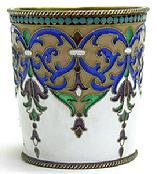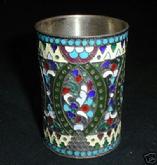Click on images below
| |
for more information
|
|
Large Cloisonne Enamel Spoon "St. Petersburg "
|
|
Br.Grachev beaker
|
Gold Pendant Egg
|
G.Sbitnev two beakers
|
 |
| Br.Grachev Enamel Cup |
|
| |
 |
| G.Sbitnev Enamel Cup |
|
|
|
Cloisonne Enamel Silver Napkin Ring
|
|
Petr Milukov enamel spoon
| Ivan Khlebnikov enamel spoon
|
|
Enamel cloisonne shovel spoon by Grachev * SOLD *
|
Enamel spoon by D. Nikolaev
|
Plique-a-jour spoon by Grachev
|
|
Two Cloisonne enamel spoons * SOLD *
|
|
Bowl marked-84 *SOLD*
|
Enamel sp. EA *SOLD*
|
I.Saltykov spoon # 4
|
|
Enamel cloisonne spoon with a case * SOLD *
|
Spoon by Ivan Saltykov-III
| Cloisonne enamel spoon 5 7/8"
|
|
Khlebnikov sp. *SOLD*
|
I.Saltykov cloisonne
|
Champleve monogram
|
Large spoon G.A.G. *SOLD*
| 2 spoons by Shabanov *SOLD*
|
|
Enamel case *SOLD*
|
1893 enamel box *SOLD*
|
|
|
|
Spoon by Ivan Saltykov-II |
|
|
Large spoon *SOLD*
|
1896 Coron. Cup *SOLD*
|
Enamel kovsh *SOLD*
|
|
G.Klingert salt spoon-pin
|
Salt spoon V.Andreev *SOLD*
|
|
2 Sp. N.Alekseev *SOLD*
|
|
I.Khlebnikov goblet
|
|
Russian enamel salt spoon by famous Ivan Saltukov *SOLD*
|
|
Flower spoon *SOLD*
|
Sp. N.Alekseev. *SOLD*
|
Enamel cloisonne egg
|
Enamel Cloisonne spoon by Feodor Lurie
|
|
"Klingert style" I. Saltykov
|
Plique a jour strainer
|
Kuzmichev sp. *SOLD*
|
Enamel, that radiant, colourful, tender, and exquisite substance, can in the hands of an artist undergo completely unexpected transformations. It is able to convey an artist's moods and intentions so delicately and so lyrically that it is often compared to Imperssionist painting.
As material for enriching the colour of decorations on metal, enamel is a glass-like substance stained by metal oxides into different colours: red, yellow, green, black, blue, and white. It is this rich palette that so attracts artists-enamelers. In order to turn enamel into a means of expressing an artist's intentions into a means of adorning metal with colourful decoration, a special technology has to be used to achive a durable fusion of metal and enamel, the two separate materials. For this purpose pulverized enamel is applied to the surface of the metal and is heated at 700-900 *C. With respect to chemical composition, emamel can be transparent, non-transparent (opaque), fondant (colourless, transparent) or opal (translucent).
Almost all major Russian jewelery firms, such as Ovchinnikov, Faberge, Sazikov, Khlebnikov, Grachev, Nemirov-Kolodkin, Postnikov, Olovyanishnikov, Kurlyukov etc., as well as many jewelery workshops and artels used decorative enamel extensively. The firm of Khlebnikov employed the techniques of enamel over cast ground, engraving and filigree as well as champleve. By the end of the 19th century Ovchinikov had mastered another technique - that of plique-a-jour enamel, and also revived cloisonne enamel. Faberge was especially famous for using the technique of enamel over a guilloche ground.
|
|